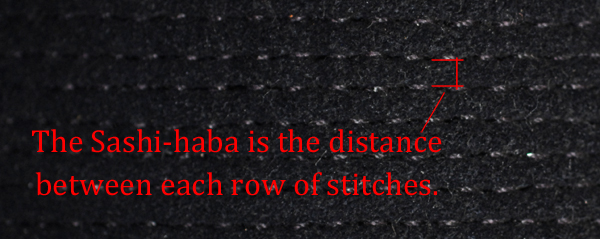Bogu Stitching Information
Stitch Width (Sashi Haba)

The stitch width refers to the size of the interval left between the rows of stitching that run through the Men, Kote, and Tare Futon. In general, this is referred to in units of Bu in the case of hand-stitched Bogu, and in units of millimeters (mm) for machine-stitched Bogu. Bu is a traditional Japanese unit of measurement, and is a fraction of the Kane-jaku or common Shaku - which itself is part of the ancient Shakkanhou measurement system. In the case of Bogu, one Bu is equal to 3.03mm.

As a rule of thumb, as the Sashi-haba gets finer, the Futon in turn becomes more thinner and more rigid, as the Futon itself is physically bound tighter. This makes it both less protective and less comfortable, however, it becomes easier to mold into a desirable shape, and is considered by many to have an overall better appearance.
If the stitch width is wider, the Futon tends to be both thicker and more flexible, making it more cushioned and comfortable. However, the trade-off is that it is harder to mold into a desirable shape, and is not as suitable for areas of the Bogu where a rigid Futon may be favored – For example, the Mendare are preferred by many to have slightly more rigidity than other areas of the Bogu, as forming them into the correct shape is critical in ensuring the fine movements are kept unseen to the opponent, ensuring the overall look of the Kamae is correct, and that the Mendare correctly deflect missed strikes away from the shoulders.
Amongst modern practitioners, the most popular choices tend to be 2.0 or 1.5 Bu for general use hand-stitched Bogu, and 4mm to 8mm for machine-stitched Bogu. While tighter stitch widths (e.g. 2-3mm) were quite common in the past, they have lost their popularity over the last few years.
However, this serves only as a general idea, and what is extremely important is NOT to base judgment on whether or not a particular Bogu set is suitable or not on the Sashi-haba alone. There are several determining factors, and if in doubt, we recommend you to contact us for any advice!
Stitch Length or Pitch (Sashi-Me)
Refers to the actual length of each individual stitch, or in other words, the size of the interval the Futon is actually pierced by the needle and thread at the time of stitching. In a similar way to the stitch width generally, the tighter the stitch pitch, the thinner and stiffer the Futon becomes.


Generally, machine-stitched Bogu uses a much tighter Sashi-me than hand-stitched Bogu. Hand-stitched Bogu almost exclusively uses the same interval for the Sashi-me, as for the Sashi-haba - in other words, in the case of Hand-stitched Bogu, the length of the stitches is almost always the same as the distance between the row of stitching (i.e. the Sashi-me of a 1.5 Bu Bogu set, will also be 1.5 Bu).
Mendare Stitching
The stitching applied to the Mendare play an important role in the flexibility, comfort and the overall appearance of the Men itself. There are three main types of stitching used on the Mendare, and they are as follows :
Naname-zashi (Diagonal Stitching)

This is simply where diagonal stitching is applied at a 45-degree angle to the main stitching on the Futon. This gives more flexibility to the Mendare, making it easier to move the shoulders when swinging the Shinai. Naname-zashi is the most common type of stitching used on the Mendare of modern-day Bogu, as it provides a good balance between comfort, protection and appearance.
Gunome-zashi

Gunome-zashi, which has become one of the more popular options in the last few years, refers to a method of stitching where an additional, usually off-set row of stitches is inserted between the standard rows of stitching. This gives the Futon more rigidity, and also makes it thinner, so it is used in places where forming the Futon into a desirable shape is important - hence it is used on the Mendare. It is most commonly seen on hand-stitched Bogu, though a similar effect can be seen on machine-stitched Bogu also - paticularly those with a wider Sashi-haba. For example, a 6mm machine-stitched Bogu may use 3mm stitching on the Mendare, to produce the same effect.
Bou-zashi (Straight Stitching)

When the main rows of stitching on the Futon continue in a straight line, all the way to the end of the Mendare, it is known as Bou-zashi. This is somewhat rare in modern machine-stitched Bogu sets, however, it is still frequently used in hand-stitched Bogu, particularly if the Sashi-haba is tight - for example, 1.2 Bu. It is preferred by some, as although it lacks the flexibility of Naname-zashi, it provides a very simplistic, classic appearance.
Juuji-zashi (Cross Stitching)

Juuji-zashi refers to stitching that incorporates both horizontal and vertical stitching, forming boxes and cross patterns across the futon. The Dare on Juuji-zashi Bogu can either continue the horizontal/vertical stitching pattern, or can have diagonal crosses, or a blend of horizontal and diagonal stitches! With this stitching pattern incorporating twice the amount of stitching, Juuji-zashi is one of the most durable stitching patterns, second only to hand-stitched sets! As a product of the stitching pattern, air is trapped in bubbles, creating an extremely protective Bogu set. While it is somewhat rare to see in machine-stitched Bogu, Juuji-zashi is often used to replicate the traditional and high-end look of hand-stitched Bogu, but in a more affordable machine-stitched format. Like hand-stitched Bogu, Juuji-zashi sets may be stiff when a tighter Sashi-haba is chosen, however we will do our best to advise you on the optimal layout for your set!
